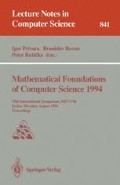Abstract
Stable bistructures axe a generalisation of event structures to represent spaces of functions at higher types; the partial order of causal dependency is replaced by two orders, one associated with input and the other output in the behaviour of functions. They represent Berry's bidomains. The representation can proceed in two stages. Bistructures form a categorical model of Guard's linear logic consisting of a linear category together with a comonad. The comonad has a co-Kleisli category which is equivalent to a cartesian-closed full subcategory of Berry's bidomains. A main motivation for bidomains came from the full abstraction problem for Plotkin's functional language PCF. However, although the bidomain model incorporates both the Berry stable order and the Scott pointwise order, its PCF theory (those inequalities on terms which hold in the bidomain model) does not include that of the Scott model. With a simple modification we can obtain a new model of PCF, combining the Berry and Scott orders, which does not have this inadequacy.
Basic Research in Computer Science, Centre of the Danish National Research Foundation.
Preview
Unable to display preview. Download preview PDF.
References
Abramsky, S., Jagadeesan, R., and Malacaria, P., Games and full abstraction for PCF (first and second preliminary announcement). Linear Logic and Types electronic newsgroups, 1993.
Berry, G., Modèles complètement adéquats et stables des lambda-calculs typés. Thèse de Doctorat d'Etat, Université de Paris VII, 1979.
Berry, G.,and Curien, P-L., Sequential algorithms on concrete data structures. Theoretical Computer Science 20, pp. 265–321, 1982.
Berry, G., Curien, P-L., and Levy, J-J., The full-abstraction problem: state of the art. Proc. French-US Seminar on the Applications of Algebra to Language Definition and Compilation, Fontainebleau 1982, Cambridge University Press, 1985.
Bucciarelli, A., Sequential models of PCF: some contributions to the domain-theoretic approach to full abstraction. PhD thesis in Computer Science, University of Pisa, March 1993.
Ehrhard, T., Hypercoherences: a strongly stable model of linear logic. Mathematical Structures in Computer Science, 1993.
Curien, P-L., Categorical combinators, sequential algorithms, and functional programming. Second edition, Birkhäuser, 1993.
Girard, J-Y., Linear logic. Theoretical Computer Science 50, 1987.
Hyland, J.M.E., and Ong, C-H.L., Games and full abstraction for PCF. Linear Logic and Types electronic newsgroups, 1993.
Jim, T., and Meyer, A., Full abstraction and the context lemma. Invited lecture, proceedings of Theoretical Aspects of Computer Software, Sendai, Springer Lecture Notes in Computer Science 526, 1991.
Hoofman, R., Nonstable models of linear logic. PhD thesis, University of Utrecht, 1992.
Milner, A.R.G., Fully abstract models of typed lambda-calculi. Theoretical Computer Science 4(1), pp. 1–23, 1977.
Nielsen, M., Plotkin, G.D., and Winskel, G., Petri nets, Event structures and Domains, part 1. Theoretical Computer Science, vol. 13, 1981.
Plotkin, G.D., LCF considered as a programming language. Theoretical Computer Science 5(3), pp. 223–256, 1977.
Plotkin, G.D., and Winskel, G., Bistructures, bidomains and linear logic. To appear in the proceedings of ICALP 94, Springer Lecture Notes in Computer Science, 1994.
Seely, R.A.G., Linear logic, *-autonomous categories and cofree coalgebras. Contempory Mathematics, vol.92, 1989.
Winskel, G., Events in Computation. PhD thesis, University of Edinburgh, available as a Comp. Sc. report, 1980.
Winskel, G., Event structures. Lectures for the Advanced Course on Petri nets, September 1986, Springer Lecture Notes in C.S., vol.255, 1987.
Winskel, G., An introduction to event structures. In the lecture notes for the REX summerschool in temporal logic, May 88, in Springer Lecture Notes in C.S., vol.354, 1989.
Author information
Authors and Affiliations
Editor information
Rights and permissions
Copyright information
© 1994 Springer-Verlag Berlin Heidelberg
About this paper
Cite this paper
Winskel, G. (1994). Stable bistructure models of PCF. In: Prívara, I., Rovan, B., Ruzička, P. (eds) Mathematical Foundations of Computer Science 1994. MFCS 1994. Lecture Notes in Computer Science, vol 841. Springer, Berlin, Heidelberg. https://doi.org/10.1007/3-540-58338-6_66
Download citation
DOI: https://doi.org/10.1007/3-540-58338-6_66
Published:
Publisher Name: Springer, Berlin, Heidelberg
Print ISBN: 978-3-540-58338-7
Online ISBN: 978-3-540-48663-3
eBook Packages: Springer Book Archive

